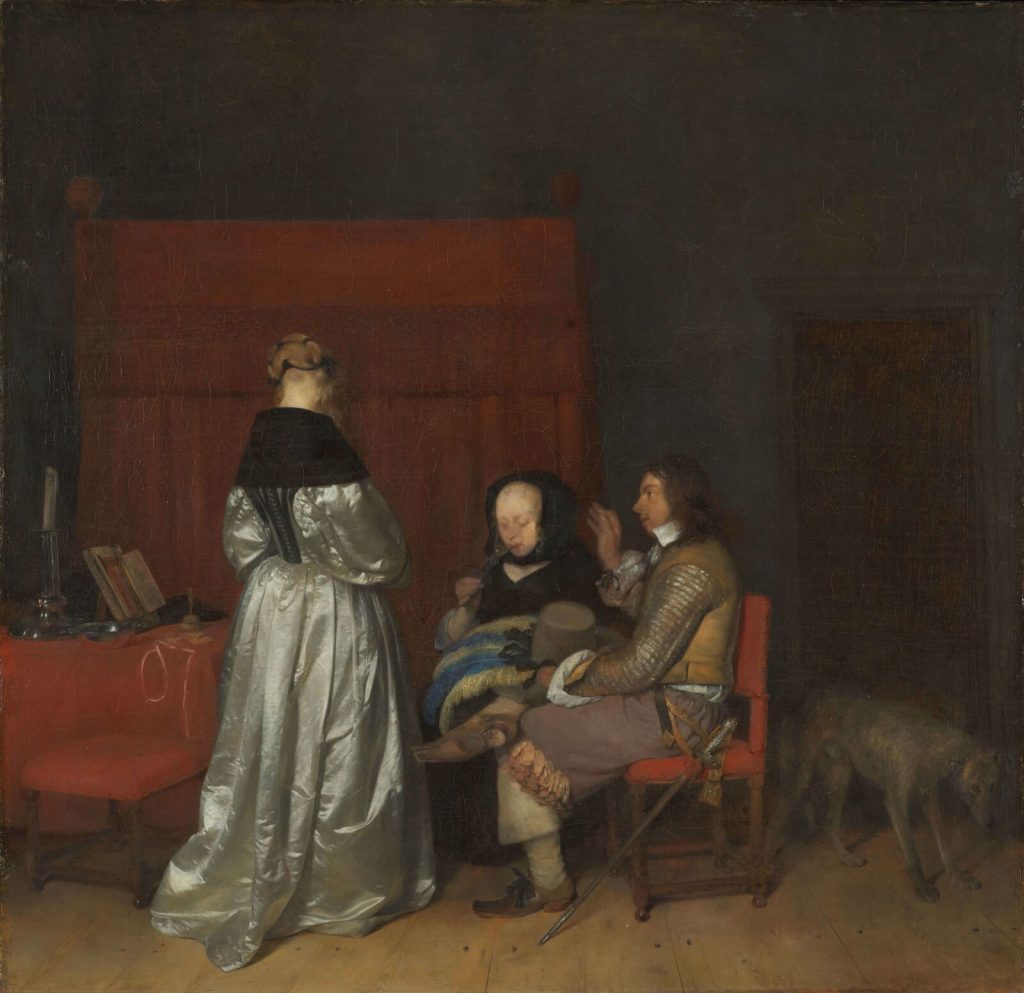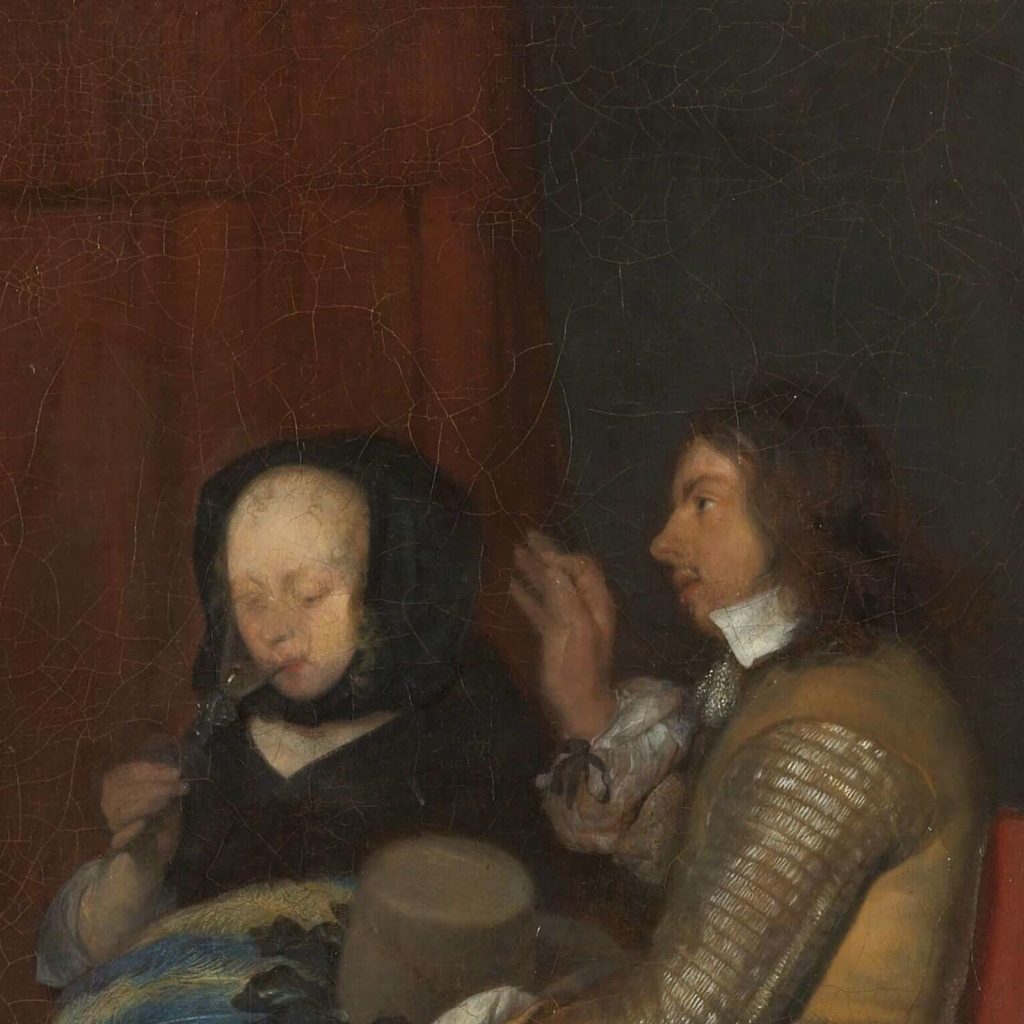Masterpiece Story: Dynamism of a Dog on a Leash by Giacomo Balla
Giacomo Balla’s Dynamism of a Dog on a Leash is a masterpiece of pet images, Futurism, and early 20th-century Italian...
James W Singer, 23 February 2025
8 December 2024 min Read
Gallant Conversation by Gerard ter Borch is a genre painting filled with a mysterious narrative. What are the three people doing? Why are they in a bedroom?

Gerard ter Borch, Gallant Conversation, ca 1654, Rijksmuseum, Amsterdam, Netherlands.
The 17th century was the apogee for Dutch genre painting. It was a time when a rich merchant class dominated society, and it sought aristocratic artwork to establish its assumptive aspirations. Genre paintings captured the leisurely lifestyle of its patrons and therefore became extremely popular. They were and still are visually opulent, stylistically sophisticated, and technically superior. The biblical and mythological scenes of the 16th century were abandoned for contemporary life filled with gallant men and attractive women. The 1650s is when a brilliantly talented artist, Gerard ter Borch, entered mainstream appreciation. He would develop the back-to-the-viewer motif to the point of a trademark. His Gallant Conversation of circa 1654 displays this signature trademark with a woman’s back dominating the scene.

Gerard ter Borch, Self-Portrait, 1668, Mauritshuis, The Hague, Netherlands.
Gallant Conversation is an oil on canvas measuring 73 cm (28.7 in) wide and 71 cm (28 in) high. It is a lifelike and natural depiction of a dimly lit bedroom with three figures. An elegant woman, with her back to the viewer, stands one-third from the left edge. Facing her is a gallant soldier who is sitting in profile. Between the young attractive pair, facing the viewer, is an older but still fashionable woman. To the far right is a large dog with glaring eyes. What are these three people and a dog doing collectively in this bedroom scene? Complex human relationships are difficult to interpret, and feelings and emotions are seldom straightforward. However, there are two valid interpretations to this ambiguous scene.

Gerard ter Borch, Gallant Conversation, ca 1654, Rijksmuseum, Amsterdam, Netherlands. Detail.
The standing young woman dominates the scene with her face hidden and her back displayed. She is evocative and mysterious. Her pale white satin dress cascades from her shoulders and flows full-length to the floor. It is a materialistic showstopper of satin resplendence. Gerard ter Borch was a master painter of this fabric and developed a cornerstone of his painterly reputation on his satin depictions. Look how each fold and ripple of the woman’s dress has individual highlights and shadows. Look how the yellow floor is reflected upwards on the dress giving the satin a yellowish cast near her heels. Like a shaded candle, the woman radiates light. She is a beacon for the other two persons in the scene. However, does she gain their attention through positive or negative means?

Gerard ter Borch, Gallant Conversation, ca 1654, Rijksmuseum, Amsterdam, Netherlands. Detail.
The standing woman’s face is hidden with her back to the viewer. Therefore, we cannot see her reaction to the soldier’s spoken words. The soldier wears a fashionable uniform with all the tasteful accessories of his rank. He has an officer’s sword attached at his waist that now leans against the chair. He holds a large feathered hat in his left hand that is exquisitely colored with cobalt blue plumage. His wrists and neck are highlighted in stark white lace signifying his wealth and cleanliness. He is the model of a genteel officer. However, are his motives genteel or ghastly? Why is he addressing a young woman in her bedroom?

Gerard ter Borch, Gallant Conversation, ca 1654, Rijksmuseum, Amsterdam, Netherlands. Detail.
Who is the mature woman? What is she doing sitting between her two younger companions? She is the centerpiece of this hidden plotline. She is the key to unlocking this mystery. Look at her closely. Look at what she is doing. She is drinking from a fragile wine glass. What does that signify? It could signify nothing, or it could signify that her character is tainted by the deepest immorality. Alcohol and sex easily go hand-in-hand. It is a combination just as dangerous now as it was in the mid-17th century. Therefore, who is she, and what does she imply to the painting’s narrative?

Gerard ter Borch, Gallant Conversation, ca 1654, Rijksmuseum, Amsterdam, Netherlands. Detail.
A dutiful mother or a lecherous procuress. Shocking contrasts, but contrastingly valid options. The most famous painting by Gerard ter Borch depicts either a virtuous scene of a suitor approaching a mother to court her daughter, or a scandalous scene of a client seeking a madam to rent her prostitute. Is it virtuous love or is it sinful lust? Which interpretation is the most likely?

Gerard ter Borch, Gallant Conversation, ca 1654, Rijksmuseum, Amsterdam, Netherlands. Detail.
Gerard ter Borch, Gallant Conversation, Rijksmuseum’s Online Collection. Retrieved 31 July 2023.
Gerard ter Borch, Self-Portrait, Mauritshuis’ Online Collection. Retrieved 2 August 2023.
Adriaan E. Waiboer, Arthur K. Wheelock, Blaise Ducos. Vermeer and the Masters of Genre Painting. Translated by Caroline Beamish and Diane Webb. New Haven, CT, USA: Yale University Press, 2017.
DailyArt Magazine needs your support. Every contribution, however big or small, is very valuable for our future. Thanks to it, we will be able to sustain and grow the Magazine. Thank you for your help!